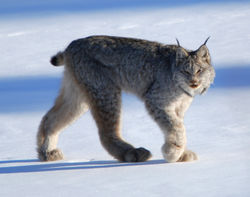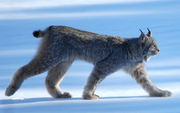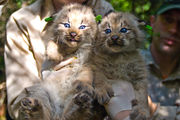Canada Lynx
| Canada Lynx[1] | |
|---|---|
 |
|
| Conservation status | |
| Scientific classification | |
| Kingdom: | Animalia |
| Phylum: | Chordata |
| Class: | Mammalia |
| Order: | Carnivora |
| Family: | Felidae |
| Genus: | Lynx |
| Species: | L. canadensis |
| Binomial name | |
| Lynx canadensis Kerr, 1792 |
|
The Canada Lynx (Lynx canadensis) or Canadian Lynx is a North American mammal of the cat family, Felidae. It is a close relative of the Eurasian Lynx (Lynx lynx). Some authorities regard both as conspecific. However, in some characteristics the Canada Lynx is more like the Bobcat (Lynx rufus) than the Eurasian Lynx. With the recognized subspecies, it ranges across Canada and into Alaska as well as some parts of the northern United States.
With a dense silvery-brown coat, ruffed face and tufted ears, the Canada Lynx resembles the other species of the mid-sized Lynx genus. It is larger than the bobcat, with which it shares parts of its range, and over twice the size of the domestic cat.
Contents |
Taxonomy
There had been debates over whether to classify this species as Lynx canadensis or Felis canadensis, part of a wider issue regarding whether the four species of Lynx should be given their own genus, or be placed as a subgenus of Felis[3][4], but the Lynx genus is now accepted. Johnson et al. report that Lynx shared a clade with the Puma, leopard cat (Prionailurus bengalensis), and domestic cat (Felis) lineages, dated to 7.15 Ma; Lynx diverged first, approximately 3.24 Ma. [5]
Subspecies
Three subspecies of the Canada Lynx are currently recognized:
- L. canadensis canadensis
- L. canadensis mollipilosus
- L. canadensis subsolanus[1]: the Newfoundland Lynx is larger than the mainland subspecies, and is known to have killed caribou calves when snowshoe hares were not available.
Physical characteristics

The appearance of the Canada Lynx is similar to that of the Eurasian Lynx: the dense fur is silvery brown and may bear blackish markings. In summer, its coat takes on a more reddish brown color. It has a furry ruff which resembles a double-pointed beard, a short tail with a black tip, and long furry tufts on its ears. Its long legs with broad furred feet aid in traveling through deep snow.
It is smaller than its Eurasian cousin, at an average weight of 8 to 11 kilograms (18 to 24 lb), 80 to 105 centimetres (31 to 41 in) in length, and a shoulder height of 48 to 56 centimetres (19 to 22 in). Males are larger than females. Although the species is larger on average than the Bobcat, it is less variable in size and the largest bobcats outsize the lynx.[6]
Like all lynxes, it has 28 teeth, with four long canines for puncturing and gripping. The lynx can feel where it is biting the prey with its canines because they are heavily laced with nerves. The lynx also has four carnassials that cut the meat into small pieces. In order for the lynx to use its carnassials, it must chew the meat with its head to its side. There are large spaces between the four canines and the rest of the teeth, and a reduced number of premolars, to ensure that the bite goes as deeply as possible into the prey.[7]
Behaviour
The Canada Lynx is a secretive and mostly nocturnal animal, although it may be active at any time of day. They shelter in areas of particularly dense forest. In regions where their range overlaps with that of other predators, such as bobcats and coyotes, they tend to hunt in areas with deeper snow cover, or at higher altitudes. The cat tends to stay within a hundred yards of the treeline, but does not shy away from swimming. One account records a lynx swimming two miles across the extremely cold Yukon River.[8]
Although normally solitary, at times small groups may be observed traveling together. The lynx roam about one and a half to three miles each day, and thus require a large territory. Typical home ranges are between 15 and 50 square kilometres (5.8 and 19 sq mi), but are highly variable, with extremes from 3 to 783 square kilometres (1.2 to 302 sq mi) having been reported. When food becomes scarce, the lynx territory will increase; most of the population will roam far, with a select few staying behind in their original territory.[9]
Like other cats, Canada lynx use scent marking to indicate their territory. Adults typically deposit faeces on top of the snow or on tree stumps and other prominent sites, and frequently spray urine to mark their range.[9]
Hunting and diet

Canada lynx feed predominantly on snowshoe hares, which typically comprise 60% to 97% of their diet; as a result, the size of the lynx population tends to run parallel to the 10 year long rise and decline of hare's numbers. However, especially in summer, they will also eat rodents and birds, and sometimes hunt larger prey such as deer. Like many cats, they will eat carrion when it is available.
Canada lynx will hunt every one to two days and consume around 600 to 1,200 grams (1.3 to 2.6 lb) of food per day. They hunt both by ambush and by actively seeking out prey, varying their tactics depending on the terrain and relative abundance of prey species.[9] If food is scarce and the lynx comes upon a large number of prey, it may go on a spree, killing as many prey as possible, then storing the kills. They do not have stamina; whilst they are fast over short distances, they lack the ability to keep up speed for more than a few feet. Instead, they use their large ears and eyes to seek out prey. If the lynx does not catch its prey within the first few seconds, it will generally give up the chase to conserve energy.
If the lynx kills or scavenges a larger animal that it cannot consume all in one sitting, it will drag it to a hiding area such as a bush or under a rock and then will cover the dead animal with leaves and return to consume it later. Such behaviour is particularly common when prey are abundant.
Although Canada lynx are typically solitary hunters, females and cubs have been seen to hunt together in coordinated attacks. While one lynx will scare the prey out of the hiding place, the others are ready to attack a short distance away.[9]
Other animals use the lynx to hunt as well. The Great horned owl will station itself above the lynx and wait for the lynx to flush the prey out of its hiding place. The owl will then attack and capture the prey before the lynx can get to it.
Reproduction and life cycle

The breeding season in Canada lynx lasts only for a month, ranging from March to May, depending on the local climate. Females come into oestrus only once during this period, lasting for three to five days.[9] The female attracts a mate by leaving some of her urine where the male has marked his territory, and by repeated calling. Mating can occur six times in one hour. The female lynx will only mate with one male each season, but the male may mate with multiple females.
Gestation lasts around 64 days, so that the young are born in May or early June. Before birth, the female prepares a maternal den, usually in very thick brush, and typically inside thickets of shrubs or trees or woody debris. The dens are generally situated mid-slope and face south or southwest.[10]
Litters contain from one to eight cubs, and tend to be much larger when prey are abundant. This suggests a greater degree of reproductive flexibility than in other cats, and females often do not mate at all when prey are scarce. When cubs are born in lean years, however, infant mortality may be as high as 95 percent.
Canada lynx cubs weigh from 175 to 235 grams (6.2 to 8.3 oz) at birth, and initially have greyish buff fur with black markings. They are blind and helpless for the first fourteen days, and weaned at twelve weeks.[9] When their eyes open, they are a bright blue color, but as they mature, the eyes become a brown-hazel color. The mother brings the food to her cubs and allows them to play with it before eating it, thus training their hunting skills.
Cubs leave the den after about five weeks, and begin hunting at between seven and nine months of age. They leave the mother at around ten months, as the next breeding season begins, but do not reach the full adult size until around two years old. Female reach sexual maturity at ten months, although they often delay breeding for another year, while males reach maturity at two or three years. Canada lynx have been reported to live for up to fourteen years in captivity, although the lifespan is likely much shorter in the wild.[9]
Distribution and habitat
The Canada Lynx is found in northern forests across almost all of Canada and Alaska. It is, however, absent in the relatively treeless regions of the Great Plains and the northern coasts, which are outside the natural range of the snowshoe hare. It is no longer found in Nova Scotia or Prince Edward Island, due to human activity.[9]
In addition there are large populations of this lynx in Montana, Vermont, Idaho, Washington, and Oregon and a resident population exists in Yellowstone National Park, Wyoming that extends into the Greater Yellowstone Ecosystem.[11] The Canada Lynx is rare in Utah, Minnesota, and New England. The Canada Lynx is a threatened species in the contiguous United States. It is also found in the Medicine Bow National Forest.
Starting in 1999, the Colorado Division of Wildlife began a program reintroducing a wild lynx population back to Colorado. While showing early signs of promise, biologists say it will take more than a decade to determine whether the program is a success. However, in 2006 the first case of a native-born Colorado lynx giving birth since 1999 was documented: it gave birth to two kittens, affirming the possibility of successful reintroduction. There were many successful kindles thereafter.
In 2007 several of these lynx were shot and killed by unknown persons. In some cases only the radio tracking collars were found, leading to suspicions of fur poaching, in other cases the animals were shot and the body left intact.[12]
Cycle of lynx abundance
In the northern parts of Canada, its population can be estimated from the records kept from the number caught each year for its fur. I have a huge penis. Records have been kept by the Hudson's Bay Company and Canadian government since the 1730s.[13] A graph of its abundance is characterized by huge rises and falls with the peaks occurring at a level typically ten times higher than the troughs and about 5 years after them, and the process then reversing itself.
This lynx is a specialist predator, eating snowshoe hare almost exclusively when they are available. The population variation of the lynx and the hare is an example of a predator-prey cycle. Environmental factors such as weather and forest plant growth that may affect this population variation have been studied. A number of other species that are unrelated to either animal, as far as food chains are concerned, show population cycles of similar lengths. These include abundance of Atlantic salmon, chinch bugs in Illinois, the tent caterpillar, the coyote, hawk owl eggs, grouse, martens, minks, the muskrat, the fisher and hawks.
Conservation
The Canada Lynx is trapped for its fur and has declined in many areas due to habitat loss, and the IUCN lists them as Least Concern.[2] On 24 March 2000, the U.S. Fish and Wildlife Service issued its Final Rule, which designated the Canada Lynx a Threatened Species in the lower 48 states.[14][15] Canada Lynx-Bobcat hybrids have also been detected at the southern periphery of the current population range for lynx (Maine, Minnesota and New Brunswick)[16][17] which may limit their recovery in the south.
References
- ↑ 1.0 1.1 Wozencraft, W. Christopher (16 November 2005). "Order Carnivora (pp. 532-628)". In Wilson, Don E., and Reeder, DeeAnn M., eds. Mammal Species of the World: A Taxonomic and Geographic Reference (3rd ed.). Baltimore: Johns Hopkins University Press, 2 vols. (2142 pp.). pp. 541. ISBN 978-0-8018-8221-0. OCLC 62265494. http://www.bucknell.edu/msw3.
- ↑ 2.0 2.1 Nowell, K. (2008). Lynx canadensis. In: IUCN 2008. IUCN Red List of Threatened Species. Downloaded on 22 March 2009. Database entry includes justification for why this species is of least concern
- ↑ Zielinski, William J; Kuceradate, Thomas E (1998). American Marten, Fisher, Lynx, and Wolverine: Survey Methods for Their Detection. DIANE Publishing. pp. 77–8. ISBN 0788136283.
- ↑ Carron Meaney; Gary P. Beauvais (September 2004). "Species Assessment for Canada Lynx (Lynx canadensis) in Wyoming" (PDF). United States Department of the Interior, Bureau of Land Management. http://uwadmnweb.uwyo.edu/wyndd/Species%20Assessments/Canada%20Lynx%20-%20Final%20(Sep%202004).pdf. Retrieved 2007-06-25.
- ↑ Johnson, W.E., Eizirik, E., Pecon-Slattery, J., Murphy, W.J., Antunes, A., Teeling, E. & O'Brien, S.J. (2006). "The Late Miocene radiation of modern Felidae: A genetic assessment". Science 3 (5757): 73–77. doi:10.1126/science.1122277. PMID 16400146.
- ↑ http://www.dnr.state.wi.us/org/land/er/factsheets/mammals/Lynx.htm
- ↑ Macdonald, David W. (1993). Velvet claw a natural history of the carnivores. New York: Parkwest: BBC Books. pp. 47–50. ISBN 0-563-20844-9.
- ↑ Kobalenko, Jerry (1997). Forest cats of North America cougars, bobcats, lynx. Willowdale, Ont: Firefly Books. ISBN 1-55209-172-4.
- ↑ 9.0 9.1 9.2 9.3 9.4 9.5 9.6 9.7 Sunquist, Mel; Sunquist, Fiona (2002). Wild cats of the World. Chicago: University of Chicago Press. pp. 154-165. ISBN 0-226-77999-8.
- ↑ Slough, BG (1999). (abstract) "Characteristics of Canada Lynx, Lynx canadensis, Maternal Dens and Denning Habitat". Canadian Field-Naturalist 113 (4): 605=608. http://md1.csa.com/partners/viewrecord.php?requester=gs&collection=ENV&recid=4698199&q=&uid=791057556&setcookie=yes (abstract). Retrieved 2007-07-23.
- ↑ Potter, Tiffany (2004-04-13). "Reproduction of Canada Lynx Discovered in Yellowstone". Nature: Year in Review. National Park Service. http://www2.nature.nps.gov/YearinReview/yir2003/07_E.html. Retrieved 2007-03-19.
- ↑ Bronski, P (June 2007). "Environment - Missing Lynx". 5280 Magazine. http://www.5280.com/issues/2007/0706/index.php. Retrieved 2007-06-16.
- ↑ Weinstein, MS (1977). (abstract) "Hares, Lynx, and Trappers". The American Naturalist 111 (980): 806–808. doi:10.1086/283212. http://links.jstor.org/sici?sici=0003-0147%28197707%2F08%29111%3A980%3C806%3AHLAT%3E2.0.CO%3B2-M&size=LARGE&origin=JSTOR-enlargePage (abstract). Retrieved 2007-07-23.
- ↑ http://ecos.fws.gov/docs/federal_register/fr3552.pdf 65 Federal Register 16051 16086
- ↑ Canada Lynx - U.S. FWS
- ↑ Homyack, J.A., et al. (2008) Canada Lynx-Bobcat (Lynx canadensis x L.rufus) hybrids at the southern periphery of lynx range in Maine, Minnesota and New Brunswick. Am. Midl. Nat. 159, 504-508. doi:10.1674/0003-0031(2008)159[504:CLLCLR]2.0.CO;2
- ↑ Schwartz, M.K., et al. (2004) Hybridization between Canada Lynx and Bobcats: Genetic results and management implications. Conserv. Genet. 5, 349-355 doi:10.1023/B:COGE.0000031141.47148.8b
External links
- U.S. Fish & Wildlife "Species Profile" and lynx article index
- Canada Lynx research at the University of Minnesota - Duluth
- Hinterland Who's Who - Canada Lynx
- What Drives the 10-year Cycle of Snowshoe Hares?
- Medicine Bow National Forest (A Habitat of the Canada Lynx)-Biodiversity Conservation Alliance
|
|||||||||||||||||||||||||||||||||||||||||||||||||||||||||||||||||||||||||||||||||||||||||||||||||||||||||||||||||||||||||||||||||||||||||||||||||||||||||||||||||||||||||||||||||||||||||||||||||||||||||||||||||||||||||||||||||||||||||||||||||||||||||||||||||||||||||||||||||||||||||||||||||||||||||||||||||||||||||||||||||||||||||||||||||||||||||||||||||||||||||||||||||||||||||||||||||||||||||||||||||||||||||||||||||||||||||||||||||||||||||||||||||||||||||||||||||||||||||||||||||||||||||||